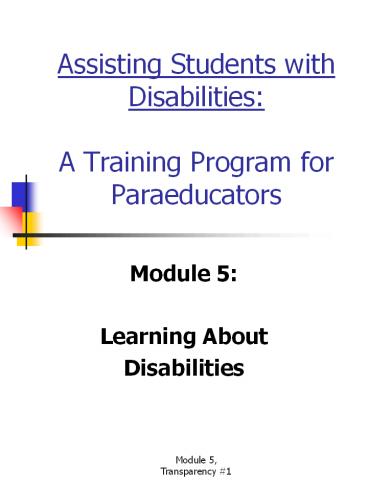Assisting%20Students%20with%20Disabilities:%20A%20Training%20Program%20for%20Paraeducators - PowerPoint PPT Presentation
Title:
Assisting%20Students%20with%20Disabilities:%20A%20Training%20Program%20for%20Paraeducators
Description:
Assisting Students with Disabilities: A Training Program for Paraeducators Module 5: Learning About Disabilities – PowerPoint PPT presentation
Number of Views:218
Avg rating:3.0/5.0
Title: Assisting%20Students%20with%20Disabilities:%20A%20Training%20Program%20for%20Paraeducators
1
Assisting Students with DisabilitiesA Training
Program for Paraeducators
- Module 5
- Learning About
- Disabilities
2
Module 5Learning About Disabilities
- Instructional Objectives
- To describe a variety of positive and negative
ways of viewing people with disabilities - To describe key principles and practices of
Special Education - To describe several ways paraeducators can assist
students with disabilities - To be familiar with Kentuckys 13 disability
categories and ways for assisting students with
these specific disabilities
3
Module Overview
- General Disability Issues
- Special Education
- Supporting Students with Disabilities
- Kentucky Disability Categories
4
General Disability Issues
- Stereotypes prejudice
- Commonly-held beliefs
- Beliefs about a group of people
- Usually negative
- Assumptions about an individual person, without
even knowing the person - Lead to unfair practices (discrimination)
- Lead to mistaken judgments
5
General Disability Issues
- Valuing people with disabilities
- Positive contributions
- Strengths abilities
- Self-determination
- Relationships
- Full citizenship
- What can you do to demonstrate these values?
6
General Disability Issues
- Use considerate language
- Person first
- Introduce by name and interests, not by
disability - Use real names of disabilities, not slang or
derogatory terms - Uses a wheelchair (not wheelchair-bound)
7
Special Education
- The recent past school exclusion for youth with
disabilities - The present
- Acknowledgement that students with disabilities
CAN benefit from education - Laws to protect the rights of people with
disabilities, including the rights of children
and youth to education
8
Special Education
- IDEA 1997
- Educational rights for children and youth ages
0-21 - Children are eligible for certain services if
they have a disability and need
specially-designed instruction in order to
benefit from school - 6 key principles
9
Special Education
- Other laws that may affect children and youth
with disabilities - The Rehabilitation Act -employment-related
services - Section 504 (of the Rehab Act) - requires schools
to provide accommodations) - ADA prohibits discrimination in all activities
programs - Tech Act helps states provide assistive
technology
10
Special Education
- Inclusion
- Teaching students with disabilities alongside
typical peers as much as possible (least
restrictive environment) - More difficult than teaching students in
segregated settings - More humane and beneficial
11
Special Education
- Inclusion how can it be done well?
- Daily collaboration between special education
teacher, general education teacher, para, and any
other service providers - Prepare for multiple levels of instruction within
the same activity/lesson - Recognize that fairness means equal opportunity
to learn
12
Supporting Studentswith Disabilities
- Get information about the student
- Collaborate with the instructional team
- Look for opportunities to help the student with
social skills and relationships - Help with coping, problem-solving,
self-determination
13
Supporting Studentswith Disabilities
- Work cooperatively with the students parents
- Encourage their participation in their
son/daughters education - Appreciate their expertise
- Provide referral information
- Be forgiving understanding
- Maintain a professional relationship (not a close
friendship)
14
Kentucky Disability Categories
- To be eligible for Special Education in Kentucky,
a student must meet criteria for at least 1 of
the following 13 disability categories - Developmental Delay
- Orthopedic Impairment
- Speech or Language Impairment
- Visual Impairment
15
Kentucky Disability Categories
- Hearing Impairment
- Deaf-Blindness
- Autism
- Emotional-Behavioral Disability
- Specific Learning Disability
- Mental Disability
- Traumatic Brain Injury
- Other Health Impairment
- Multiple Disabilities

